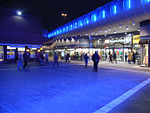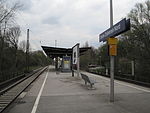Gelsenkirchen-Rotthausen station
Buildings and structures in GelsenkirchenNorth Rhine-Westphalia railway station stubsRailway stations in Germany opened in 1876Railway stations in North Rhine-WestphaliaRhine-Ruhr S-Bahn stations ... and 2 more
Rhine-Ruhr S-Bahn stubsS2 (Rhine-Ruhr S-Bahn)

Gelsenkirchen-Rotthausen is a railway station on the Essen–Gelsenkirchen railway situated in Gelsenkirchen in western Germany. It is classified by Deutsche Bahn as a category 6 station. It is served by Rhine-Ruhr S-Bahn line S 2 and by bus route 381 (Gelsenkirchen – Erle – Resse/Buer) operated by BOGESTRA.
Excerpt from the Wikipedia article Gelsenkirchen-Rotthausen station (License: CC BY-SA 3.0, Authors, Images).Gelsenkirchen-Rotthausen station
Am Dahlbusch, Gelsenkirchen Rotthausen (Gelsenkirchen-Süd)
Geographical coordinates (GPS) Address Nearby Places Show on map
Geographical coordinates (GPS)
| Latitude | Longitude |
|---|---|
| N 51.49263 ° | E 7.08901 ° |
Address
Gelsenkirchen-Rotthausen
Am Dahlbusch
45884 Gelsenkirchen, Rotthausen (Gelsenkirchen-Süd)
North Rhine-Westphalia, Germany
Open on Google Maps











